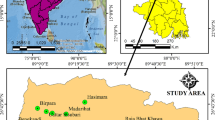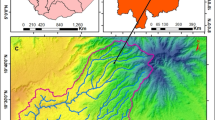Abstract
In order to develop and manage groundwater resources sustainably, it is necessary to make precise quantitative assessments based on scientific principles as well as modern techniques. Groundwater feeding is an important process for the management of surface water resources as well as underground water resources. In this study, the application of analytical hierarchy process on geographical–spatial analysis was used to investigate potential regions for groundwater feeding in Turkey, Sanliurfa, Haliliye basin. Morphology of the ground surface features such as land use, land cover, geology, geomorphology, soil, slope, drainage, linearity, and aquifers is the parameter that directly or indirectly affects groundwater supply. These layers are weighted according to the size of the groundwater feeding potential using the ArcGIS 10.2 software and other auxiliary data sources. As a result of the study, five regions were created by obtaining the groundwater potential index (GWPI) values of the basin: GWPI: very bad 0.06% (2.04 km2), bad: 18.30% (1001.16 km2), medium: 43.10% (2863.86 km2), good: 32.50% (2128.63 km2), very good: 6.04% (23.12 km2). The study's data were validated using wells drilled on the land, and the results of determining the groundwater potential of the Sanliurfa Haliliye district using the multi-criteria decision-making method were realized.











Similar content being viewed by others
Availability of data and materials
All data generated or analyzed during this study are included in this published article (and its supplementary information files).
References
Agarwal R, Garg PK (2016) Remote sensing and GIS based groundwater potential & recharge zones mapping using multi-criteria decision-making technique. Water Resour Manag 30(1):243–260
Aryafar A, Yousefi S, Ardejani FD (2013) The weight of interaction of mining activities: groundwater in environmental impact assessment using fuzzy analytical hierarchy process (FAHP) Environ. Earth Sci 68(8):2313–2324
Aslan V, Çelik R (2021) Integrated GIS-based multi-criteria analysis for groundwater potential mapping in the Euphrates’s Sub-Basin, Harran Basin, Turkey. Sustainability 13(13):7375. https://doi.org/10.3390/su13137375
Avtar R, Singh CK, Shashtri S, Singh A, Mukherjee S (2010) Identification and analysis of groundwater potential zones in Ken-Betwa River linking area using remote sensing and geographic information system. Geocarto Int 25(5):379–396
Ayazi MH, Pirasteh S, Arvin AKP, Pradhan B, Nikouravan B, Mansor S (2010) Disasters and risk reduction in groundwater: Zagros Mountain Southwest Iran using geoinformatics techniques. Disaster Adv 3(1):51–57
Backundukize C, Van Camp M, Walraevans K (2011) Estimation of groundwater recharge in Bugesera region (Burindi) Using soil moisture budget approach. Gel Bel 14:85–120
Bagyaraj M, Ramkumar T, Venkatramanan S, Gurugnanam B (2013) Application of remote sensing and GIS analysis for identifying groundwater potential zone in parts of Kodaikanal Taluk. South India Front Earth Sci 7(1):65–75
Birkeland PW (1984) Soils and geomorphology. Oxford University Press, UK
Celik R, Hamidi N (2018) Ergani İlçesi Ovasının yeraltısuyu potansiyelinin Coğrafi Bilgi Sistemi ile belirlenmesi. Dicle Üniver Mühendis Fakült Mühendis Dergisi 9(2):999–1007
Cheng CH (1997) Evaluating naval tactical missile systems by fuzzy AHP based on the grade value of membership function. Eur J Oper Res 96(2):343–350
Chowdhury A, Jha MK, Chowdhary VM, Mal BC (2009) Integrated remote sensing and GIS-based approach for accessing groundwater potential in west Medinipur district, West Bengal, India. Int J Remote Sens 30(1):231–250
Chowdhury A, Jha MK, Chowdary VM (2010) Delineation of groundwater recharge zones and identification of artificial recharge sites in West Medinipur district, West Bengal, using RS, GIS and MCDM techniques. Environ Earth Sci 59(6):1209
Chu HJ, Liu C, Wang C (2013) Identifying the Relationships between Water Quality and Land Cover Changes in the Tseng-Wen Reservoir Watershed of Taiwan. Int J Environ Res Public Health 10:478–489
Dabrowski JM, De Klerk LP (2013) An Assessment of the impact of different land use activities on water quality in the Upper Olifants river catchment. Water Sa 39:231–241
Das S, Gupta A, Ghosh S (2017) Exploring groundwater potential zones using MIF technique in semi-arid region: a case study of Hingoli district, Maharashtra. Spat Inf Res 25(6):749–756
Das B, Pal SC (2019) Assessment of groundwater recharge and its potential zone identification in groundwater-stressed Goghat-I block of Hugli District, West Bengal, India. Environ Dev Sustain. https://doi.org/10.1007/s10668-019-00457-7
Das S (2019) Comparison among influencing factor, frequency ratio, and analytical hierarchy process techniques for groundwater potential zonation in Vaitarna Basin, Maharashtra, India. Groundw Sustain Dev 8:617–629
Dasho OA, Ariyibi EA, Akinluyi FO, Awoyemi MO, Adebayo AS (2017) Application of satellite remote sensing to groundwater potential modeling in Ejigbo area, Southwestern. Nigeria Model Earth Syst Environ 3(2):615–633
Dias LCP, Macedo MN, Costa MH, Coe MT, Neill C (2015) Effects of land cover change on evapotranspiration and streamflow of small catchments in the Upper Xingu River Basin, Central Brazil. J Hydrol Reg Stud 4:108–122
Dilekoglu MF, Aslan V (2021) Determination of groundwater potential distribution of Ceylanpinar Plain (Turkey) in Upper Mesopotamia by using geographical information techniques and Fuzzy-AHP with MCDM. Water Supply. https://doi.org/10.2166/ws.2021.268
El Mekki OA, Laftouhi NE (2016) Combination of a geographical information systemand remote sensing data to map groundwater recharge potential in arid to semi-arid areas: the Haouz Plain. Morocco Earth Sci Inf 9(4):465–479
Elmahdy SI, Mohamed MM (2016) Land use/land cover change impact on groundwater quantity and quality: A case study of Ajman Emirate, the United Arab Emirates, using remote sensing and GIS. Arab J Geosci 9:722
Fitts CR (2002) Groundwater science. Elsevier (Academic Press), UK
Gupta M, Srivastava PK (2010) Integrating GIS and remote sensing for identification of groundwater potential zones in the hilly terrain of Pavagarh, Gujarat. India Water Int 35(2):233–245
Han D, Currell MJ, Cao G, Hall B (2017) Alterations to groundwater recharge due to anthropogenic landscape change. J Hydrol 554:545–557
Horton RE (1932) Drainage-basin characteristics. EOS Trans Am Geophys Union 13(1):350–361
http://www.gap.gov.tr/en/ (2006)
Ingebritsen S, Gleeson T (2017) Crustal permeability. Hydrogeol J 25(8):2221–2224
Jothibasu A, Anbazhagan S (2016) Modeling groundwater probability index in Ponnaiyar River basin of South India using analytic hierarchy process. Model Earth Syst Environ 2(3):109
Kaliraj S, Chandrasekar N, Magesh NS (2014) Identification of potential groundwater recharge zones in Vaigai upper basin, Tamil Nadu, using GIS-based analytical hierarchical process (AHP) technique. Arab J Geosci 7(4):1385–1401
Kavas E (2009) Geographical information systems based investigation of landslide sensitivity in İzmir Province with analytical hierarchical process method. In: TMMOB geographical information systems congress (CBS2009), 02–06 November, Izmir, Turkey
Kumar P, Herath S, Avtar R, Takeuchi K (2016) Mapping of groundwater potential zones in Killinochi area, Sri Lanka, using GIS and remote sensing techniques. Sustain Water Resour Manag 2:419–430
Malczewski J (1999) GIS and multicriteria decision analysis. Wiley, New York
Malczewski J, Rinner C (2015) Multicriteria decision analysis in geographic information science. Springer, New York
Mallick J, Al-Wadi H, Rahman A, Ahmed M (2014) Landscape dynamic characteristics using satellite data for a mountainous watershed of Abha, Kingdom of Saudi Arabia. Environ Earth Sci 72(12):4973–4984
Mallick J, Singh CK, Al-Wadi H, Ahmed M, Rahman A, Shashtri S, Mukherjee S (2015) Geospatial and geostatistical approach for groundwater potential zone delineation. Hydrol Process 29(3):395–418
Melton MA (1957) An analysis of the relations among elements of climate, surface properties, and geomorphology. Columbia University, New York
Ouma YO, Tateishi R (2014) Urban flood vulnerability and risk mapping using integrated multi-parametric AHP and GIS: methodological overview and case study assessment. Water 6:1515–1545
Ozbek A (2014) Determination of managers with multi-criteria decision making method. J Manag Econ Stud 12(24):209–225
Ozturk D, Batuk F (2010) Using analytic hierarchy method in spatial decision problems. Yildiz Tech Univer Sigma J Eng Sci 28:124–137
Pelling M (2003) Natural disaster and development in a globalizing world. Routledge, Abingdon
Plyusnin AM, Zamana LV, Shvartsev SL, Tokarenko OG, Chernyavskii MK (2013) Hydrogeochemical peculiarities of the nitric thermal water composition in the Baikal Rift Zone. Russ Geol Geophys 5:495–508. https://doi.org/10.1016/j.rgg.2013.04.002
Rahmati O, Samani AN, Mahdavi M, Pourghasemi HR, Zeinivand H (2015) Groundwater potential mapping at Kurdistan region of Iran using analytic hierarchy process and GIS. Arab J Geosci 8(9):7059–7071
Rajaveni SP, Brindha K, Elango L (2017) Geological and geomorphological controls on groundwater occurrence in a hard rock region. Appl Water Sci 7(3):1377–1389
Saaty TL (1990) How to make a decision: the analytic hierarchy process? Eur J Oper Res 48:9–26
Saaty TL (2008) Decision making with the analytic hierarchy process. Int J Serv Sci 1(1):83
Sar N, Khan A, Chatterjee S, Das A (2015) Hydrologic delineation of ground water potential zones using geospatial technique for Keleghai River Basin, India. Model Earth Syst Environ 1(3):25
Schrick B, Hydutsky BW, Blough JL, Mallouk TE (2004) Delivery vehicles for zerovalent metal nanoparticles in soil and groundwater. Chem Mater 16(11):2187–2193
SHW (State Hydraulic Works) (1972) Hydrogeological study of the Harran plain. DSI Printing Office, Ankara, p 49
Silwal CB, Pathak D (2018) Review on practices and state of the art methods on delineation of ground water potential using GIS and remote sensing. Bull Dep Geol. https://doi.org/10.3126/bdg.v20i0.20717
Singh PK, Kumar S, Singh U (2011) Groundwater resource evaluation in the Gwalior area, India, using satellite data: an integrated geomorphological and geophysical approach. Hydrogeol J. https://doi.org/10.1007/s10040-10011-10758-10046
Tepoule N, Kenfack JV, Ndoh EN, Koumetio F, Tabod CT (2021) Delineation of groundwater potential zones in Logbadjeck, Cameroun: an integrated geophysical and geospatial study approach. Int J Environ Sci Technol. https://doi.org/10.1007/s13762-021-03259-5
Thakur JK (2011) Arsenic contamination of groundwater in Nepal—an overview. Water 3(1):1–20
Van Roosmalen L, Christensen BSB, Sonnenborg TO (2007) Regional differences in climate change impacts on groundwater and stream discharge in Denmark. Vadose Zone J 6(3):554–571. https://doi.org/10.2136/vzj2006.0093
Wardana A (2018) Perencanaan dinding penahan tanah pada ruas jalan tol samarinda-balikpapan segmen 2 STA 06+ 525. STA 6:650
West LJ, Odling NE (2014) Groundwater. In: Water resources–an integrated approach by Joseph Holden. Routledge, New York
Zionts S, Wallenius J (1976) An interactive programming method for solving the multiple criteria problem. Manage Sci 22(6):652–663
Funding
Not applicable.
Author information
Authors and Affiliations
Contributions
V.A. was involved in investigation, methodology, formal analysis, writing—original draft; M.F.D. helped in supervision and writing—review and editing.
Corresponding author
Ethics declarations
Conflict of interest
The authors declare that they have no known competing financial interests or personal relationships that could have appeared to influence the work reported in this paper.
Ethical approval
This article does not contain any studies with human participants or animals performed by any of the authors.
Consent for publication
The manuscript is original. It has not been published previously by any of the author and even not under the consideration in any other journal at the time of submission.
Additional information
Editorial responsibility: Parveen Fatemeh Rupani.
Rights and permissions
About this article
Cite this article
Aslan, V., Dilekoğlu, M.F. Groundwater potential mapping with geographical information techniques for a sustainable environment in Haliliye Basin, Turkey. Int. J. Environ. Sci. Technol. 19, 10337–10352 (2022). https://doi.org/10.1007/s13762-021-03829-7
Received:
Revised:
Accepted:
Published:
Issue Date:
DOI: https://doi.org/10.1007/s13762-021-03829-7




